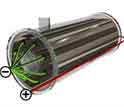News Release 05-064
Waste Not, Want Not
Bacteria-driven cell produces hydrogen for fuel while cleaning wastewater

Hong Liu (left) and Bruce Logan examine the microbial reactor system.
April 25, 2005
This material is available primarily for archival purposes. Telephone numbers or other contact information may be out of date; please see current contact information at media contacts.
By harnessing the efforts of billions of bacteria, researchers have engineered a bio-filtration system that produces hydrogen gas while cleaning wastewater – gas that could potentially fuel other machines. Up to 100 percent more efficient at producing hydrogen than similar bio-filtration systems, the new device has the added benefit of being able to digest human or animal waste, plant material or just about any organic matter.
Hong Liu and Bruce Logan of Penn State University and Stephen Grot of Ion Power, Inc. of New Castle, Del. announced their findings online April 22, 2005, in the journal Environmental Science and Technology.
A Penn State University press release is available at: http://www.psu.edu/ur/2005/hydrogensource.html. A follow-up release about a scaling-up of the microbial fuel cell technology is at: http://live.psu.edu/index.php?sec=vs_highlight&story=23030&highlight=1
Bruce Logan, Hong Liu and Stephen Grot recently won a Popular Mechanics Breakthrough Award for their work on microbe-driven fuel cells.
This research was supported by NSF Award #0401885:
Improving Power Generation in Microbial Fuel Cells http://www.nsf.gov/awardsearch/showAward.do?AwardNumber=0401885
Additional Award information
The recent innovation builds upon an NSF Small Grant for Exploratory Research (SGER). For 15 years, NSF has made a small number of SGER grants--each for 1 to 2 years duration and for amounts up to $200,000--that address especially novel, or urgent, research ideas. Logan credits his SGER award with providing a critical spark that helped drive his microbial fuel-cell research.
The SGER research generated an earlier NSF press release, and an animation of the bio-filtration device. Both can be found at: http://www.nsf.gov/news/news_summ.jsp?cntn_id=100337
NSF Award #0331824:
SGER: Determination of the Potential for Direct Generation of Electricity from Wastewater Using a Microbial Fuel Cell
http://www.nsf.gov/awardsearch/showAward.do?AwardNumber=0331824
-NSF-
-
View Video
A related microbial fuel cell was developed last year at Pennsylvania State University.
Credit and Larger Version
Media Contacts
Joshua A. Chamot, NSF, (703) 292-7730, email: jchamot@nsf.gov
Andrea Messer, Pennsylvania State University, (814) 865-9481, email: aem1@psu.edu
Program Contacts
Thomas D. Waite, NSF, (703) 292-7499, email: twaite@nsf.gov
Principal Investigators
Bruce Logan, Pennsylvania State University, (814) 863-7908, email: blogan@psu.edu
The U.S. National Science Foundation propels the nation forward by advancing fundamental research in all fields of science and engineering. NSF supports research and people by providing facilities, instruments and funding to support their ingenuity and sustain the U.S. as a global leader in research and innovation. With a fiscal year 2023 budget of $9.5 billion, NSF funds reach all 50 states through grants to nearly 2,000 colleges, universities and institutions. Each year, NSF receives more than 40,000 competitive proposals and makes about 11,000 new awards. Those awards include support for cooperative research with industry, Arctic and Antarctic research and operations, and U.S. participation in international scientific efforts.
Connect with us online
NSF website: nsf.gov
NSF News: nsf.gov/news
For News Media: nsf.gov/news/newsroom
Statistics: nsf.gov/statistics/
Awards database: nsf.gov/awardsearch/
Follow us on social
Twitter: twitter.com/NSF
Facebook: facebook.com/US.NSF
Instagram: instagram.com/nsfgov

